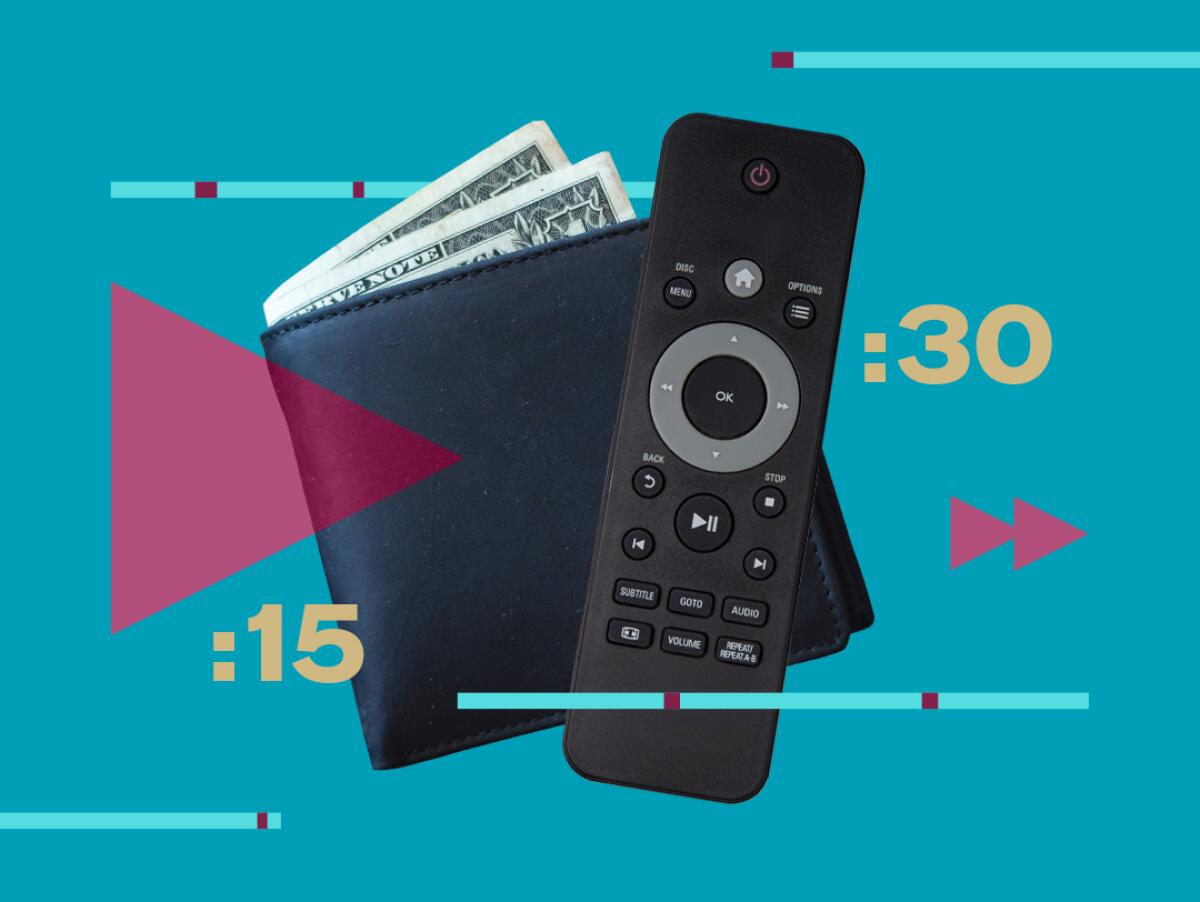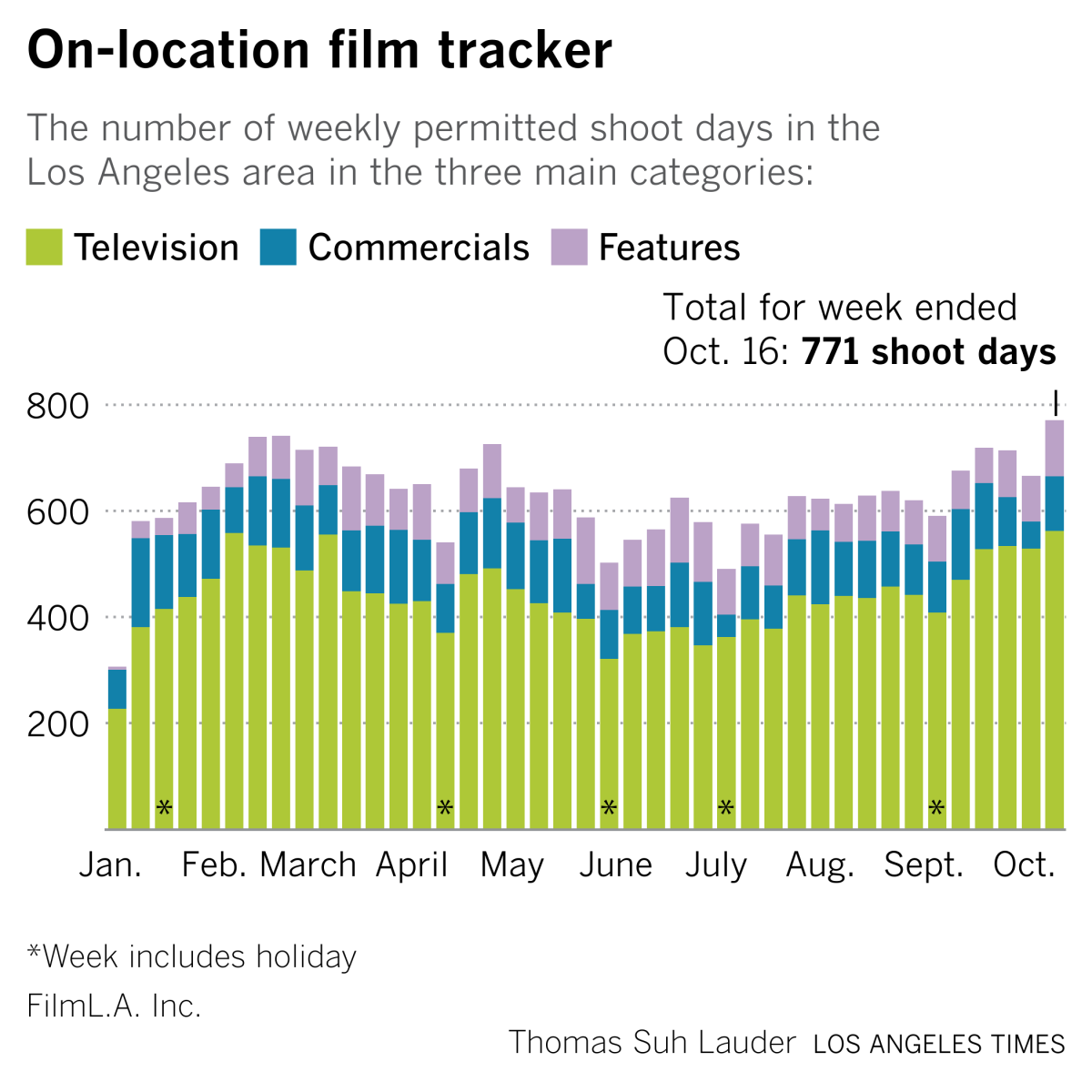How Netflix can innovate: Make ads on streaming less weird

- Share via
Welcome to the Wide Shot, a newsletter about the business of entertainment. Sign up here to get it in your inbox.
Good morning from Los Angeles. In entertainment business news, Rupert Murdoch is considering reuniting Fox and News Corp. Kanye West has entered an agreement to acquire Parler, a social media platform loved by MAGA conservatives because of its lack of political guardrails. Comcast is killing the G4 network again.
“Halloween Ends” is the No. 1 movie at the box office, scoring a so-so domestic opening weekend of $41.2 million while also debuting on Peacock. Maybe this is just the natural decline of a successful horror trilogy. Maybe it’s a sign that more people have figured out what Peacock is. On with the newsletter ...
Ads on streaming services are weird
The logic behind Netflix’s introduction of a cheaper, advertising-supported subscription tier is pretty simple. Facing a slowdown in subscriber gains and more competition than ever, the company is hoping its new offering is enticing enough to attract fresh price-sensitive customers, while also convincing its more fickle current subscribers to stick around for a lower-cost option.
The timing is opportune, considering the increasingly cloudy economic picture.
“Right now, especially as inflation rises, everybody’s looking for a sale in every part of their lives,” said Monica Koyama, an associate communications professor at USC’s Annenberg School for Communication and Journalism and a former vice president of creative services and movie marketing at FX Networks.
At $6.99 a month in the U.S., the new bargain Netflix is $1 cheaper than the ad-based tiers offered by Hulu and soon Disney+. It’s $3 lower than HBO Max with ads, but also $2 more than the versions of Peacock and Paramount+ that include commercials.
By hitting right at the middle of the market, Netflix seems to have found a reasonable entry point. It’s made the jump quickly, bringing its ad-based tier to market a little earlier than expected, and disclosing details just six months after co-Chief Executive Reed Hastings casually stated his openness to the idea in an April earnings call.
As for nuts and bolts, which my colleague Wendy Lee describes here, the ad-based option launches Nov. 3 in the U.S. and will feature four to five minutes of advertising per hour of programming, including 15-second and 30-second commercials, both as preroll and during shows and films. The “basic with ads” version has some technical limitations and won’t include some titles because of licensing issues, which Netflix says it will try to resolve over time. It won’t allow you to download shows to your device. Overall, it’s pretty standard stuff.
Ads will surely be a major focus of Netflix’s earnings call this afternoon, and I’ll refrain from making any predictions here. Analysts have been generally positive about the shift, with some reservations, including the potential for the with-ads version to cannibalize Netflix’s commercial-free subscriber counts. Surely, some people will switch over, just to save a few bucks.
According to a Wall Street Journal report, Netflix expects to have about 40 million “unique viewers” for its ad tier in late 2023, a metric that’s likely higher than the projected number of subscribers because households often include more than one person. Cowen & Co. projects the cheaper version will bring in 4 million subs in 2023 in the U.S. and Canada alone.
Netflix clearly believes it can make up for any sacrifice in subscription revenue with the money it makes from advertisers. Wedbush analysts estimated that Netflix could create $10 in monthly ad revenue per account, on top of the $7 monthly subscription fee. Subscribers to Netflix’s standard plan pay $15.49 a month.
One of the challenges for Netflix, and many other programmers nowadays, is that shows made for streaming aren’t written or filmed with ad breaks in mind, the way sitcoms and police procedurals are. As often as steaming has been described as the new broadcast and cable TV, they’re actually quite different models with different styles of programming. Splicing ads into something that wasn’t built for them can make the viewing experience pretty weird as companies retrofit their services for the ad-based model.
Here’s an example. A few months ago, I switched to the ad-supported version of HBO Max to save a little cash, and even paid for the whole year for an additional discount. So that was $99 for the annual plan, versus the $180 I would’ve paid over a year if I had stuck with the commercial-free month-to-month option. A good deal, financially. The downside is that I found the experience of watching the HBO Max originals — such as “Hacks” and “The Flight Attendant” — somewhat jarring with commercial interruptions after previously watching them with none. It took a while to get used to it, but I did.
It’s not an insurmountable issue, considering the savings for inflation-squeezed households, but it’s one to consider, as Netflix surely knows.
Netflix chief operating officer and chief product officer Greg Peters said the company has tasked its “internal content tagging teams” to find natural breaks in shows where ads might fit.
As for films, Peters said newer titles would have their ads play at the beginning to preserve the cinematic experience Netflix is hoping to achieve. Older movies will be broken up by commercials, making the experience closer to what you might see on TNT or AMC. Other streamers, such as Peacock, have taken a similar approach.
“In the grand scheme of things, it’s a very pro-consumer and consumer-friendly approach to be able to offer the wide variety of entertainment that we have at a lower price for them, with the offset of this quite limited and, ideally, quite thoughtfully placed ads experience,” Peters said in a call with journalists describing the plans.
It’s easier said than done, of course, but if Netflix can make its retroactive ad placements relatively seamless, that, to this consumer, would count as an innovation in the streaming space. People have this idea about the streaming business that building a direct-to-consumer service is simple compared to the task of creating compelling movies and TV shows. Fair enough, perhaps. But I think some underestimate the importance of having an app that’s easy to navigate, looks appealing and works consistently. It’s not like producing “The Sandman,” but nor is it the easiest thing to accomplish.
User experience may seem like a small thing, and a boring one to talk about compared with discussing “Squid Game,” but it’s an important area where Netflix, with its Silicon Valley roots, has long enjoyed an edge over most competitors. The introduction of ads could test that advantage.
Stray thought: An interesting wrinkle is that Netflix has decided it won’t accept political advertising, which makes sense if it wants to maintain a happy user experience. Netflix has certainly been at the center of enough political firestorms. At the same time, Democrats ripped Hulu for refusing issue-based ads about abortion access and climate change, leading the service to change its policy. Will they have the same problem with Netflix’s stance, or was this objection reserved for Hulu and Disney?
Stuff we wrote

— Rules on how guns are used on sets are about to change after ‘Rust.’ From Anousha Sakoui: “An influential industrywide labor-management committee, composed of union and studio representatives, is weighing revisions to so-called safety bulletins that dictate how guns and ammunition should be handled in the entertainment industry.”
— Amazon is making good on its promise to bring younger viewers to the NFL. Nielsen data for the first four “Thursday Night Football” contests on the tech giant’s Prime Video streaming platform show they’re drawing a larger percentage of 18- to 34-year-olds than games shown on traditional TV, reports Stephen Battaglio.
— Warners workshop 180. Warner Bros. Discovery reversed a decision to close its television writers and directors workshops a day after the cuts were announced amid layoffs in TV operations. The company, which has been criticized for its diversity problems, will move the programs into its broader diversity, equity and inclusion arm and expand them across the rest of its content businesses. WBD is now saying this was the plan all along, which you can believe, or not.
— ICYMI. Digging into the audience numbers for ‘The Rings of Power.’ Chris Albrecht placed on leave from Legendary Entertainment. New Netflix pop-up at the Grove.
Number of the week

A jury last week hit Infowars personality and conspiracy theorist Alex Jones with a verdict of nearly $1 billion for promoting lies about the deadly shooting at Sandy Hook Elementary. The cost of not spreading conspiracy theories: $0.
Best of the web
— Jeffrey Katzenberg is done with the media business. (Insider)
— Do late night talk shows have a future? (New York Times)
— The best streaming services for anime fans. (Vulture)
— Martin Scorsese thinks our box office obsession is ‘repulsive.’ (IndieWire)
— The improbable rise and fall of Siegfried & Roy. (the Atlantic)
— Meet Mallory Rubin, the nerd queen of TV recap culture. (NYT)
Films shoots
Los Angeles on-location film shoots jumped last week, exceeding the comparable seven days of 2021 by 8%, according to FilmLA data.


Finally ...
One positive outcome of Los Angeles’ ongoing racism and corruption scandal at City Hall: This local Chicano band’s love song to Oaxaca lit up TikTok.
Inside the business of entertainment
The Wide Shot brings you news, analysis and insights on everything from streaming wars to production — and what it all means for the future.
You may occasionally receive promotional content from the Los Angeles Times.




